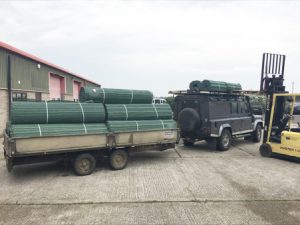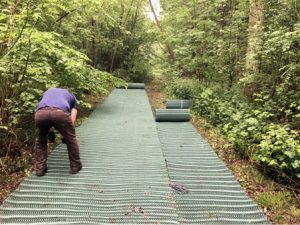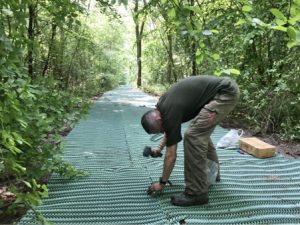Tracks, a new solution for the Small Woodland Owner.

As a company, we strive where possible to give a good access track into the woodlands we bring to market. In some instances, this means just clearing a ride. However, in some cases, the areas need more drastic action such as creating areas of “stone” tracks or rides. Normally this is due to areas holding water or ground being prone to deep rutting in winter.
We came across a new problem earlier in the year with a ride that ran in a wood that was deemed to be of particular special scientific interest. Natural England were keen that we did not bring any foreign material such as crushed concrete rubble or even local stone into the woodland. Natural England did, however, agree that the ride was unusable and unless we found a solution it would be a mess very quickly.
 After some research, we found that in the past Natural England had supported the use of mesh materials on moorland to stop erosion on tracks. Terram make a product called Grass protector. It comes in two weights but I think only the heavy duty is suitable for woodland tracks. The idea is once laid grass and vegetation grows through the mesh creating a vegetation mat that not only offers year long access but also disappears from sight. Unlike stone, it can be removed and does not leach into the soil.
After some research, we found that in the past Natural England had supported the use of mesh materials on moorland to stop erosion on tracks. Terram make a product called Grass protector. It comes in two weights but I think only the heavy duty is suitable for woodland tracks. The idea is once laid grass and vegetation grows through the mesh creating a vegetation mat that not only offers year long access but also disappears from sight. Unlike stone, it can be removed and does not leach into the soil.
A huge advantage in this system to the small wood owner is that it is easy to transport to the woodland without heavy plant. I managed hiring a large trailer and using my roof rack to transport 150metres of track on each journey. I imagine that would have been about 10 lorries of stone.
 Whilst bulky the large rolls weighed just over 100 kg and could be moved around by two fit people, by placing stakes in each end. The other advantage of using a mesh system is that you do not have to undertake excessive ground works. The Tracks need to be made as flat and smooth as possible so as the mesh can be laid. A mini digger or time with a shovel sorts out most ruts. The ride needs to be mown to allow the grass, bramble etc to grow back through the matting.
Whilst bulky the large rolls weighed just over 100 kg and could be moved around by two fit people, by placing stakes in each end. The other advantage of using a mesh system is that you do not have to undertake excessive ground works. The Tracks need to be made as flat and smooth as possible so as the mesh can be laid. A mini digger or time with a shovel sorts out most ruts. The ride needs to be mown to allow the grass, bramble etc to grow back through the matting.
Its then just a case of rolling out the mesh mats, cutting to size and pinning down. The pinning down is vital as the mesh needs to be close to the ground and not “tenting” over undulations. In a 300 metre length of track we put in 4500 metal staples. Whilst time consuming and tiring the only kit you need to complete this is a lump hammer.
 It is important that you don’t drive on the mats straight away but let them “bed in” and vegetation start to grow through them. If you lay the matting in spring this should only be a few weeks. The pictures show the mats we laid in mid May and the picture to the left shows the mesh mats after 2 weeks of warm, wet weather.
It is important that you don’t drive on the mats straight away but let them “bed in” and vegetation start to grow through them. If you lay the matting in spring this should only be a few weeks. The pictures show the mats we laid in mid May and the picture to the left shows the mesh mats after 2 weeks of warm, wet weather.
Its too early to say how long this system will last, but repairs should just involve stapling on a new section over the broken old one. I hope that the mesh will totally disappear from sight and offer a rugged substructure to the ride.
For a small woodland owner with small areas of tracks and rides this maybe a useful solution and one that can be DIYed with no prior experience and only a healthy dose of labour.
Comments are closed for this post.

Hi Matt
How’s the access track mat holding up now. Is it still providing year round access?
Cheers
Mark
Mark
11 July, 2022